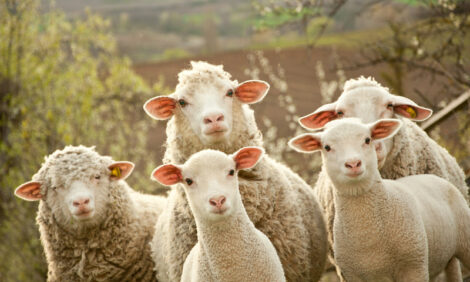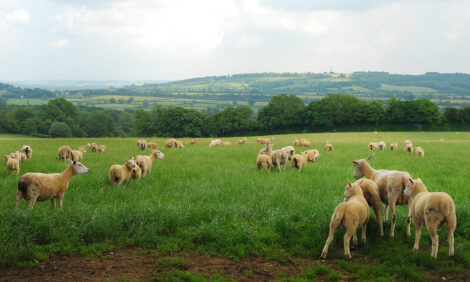



World Dairy Summit: Krysta Harden offers US dairy export status
Harden says trust is key around the world when it comes to building new export marketsKrysta Harden, president and CEO, US Dairy Export Council (US DEC), spoke to The Dairy Site’s Sarah Mikesell at the World Dairy Summit in Chicago in October 2023.
Tell us about the World Dairy Summit.
We have more than 1,000 people here from 55 countries. We are excited to be the host this year. The summit happens every year, but this is the first time in 30 years that the US has been the host. We are ready to showcase and highlight everything about US dairy.
What is happening in the US dairy market?
It is always a tough time, it seems, for dairy farmers, but demand for dairy continues to grow. We can appreciate that, but we have had a lot of tough weather conditions. You can pick a state or region, and there have been challenges over this year.
Our farmers are resilient and persistent. They are consistently working hard to make sure we have a great product to share with everyone.
What is the status of US dairy exports?
I lead the export area, which is a growing focus for our industry. Back when US DEC was formed almost 28 years ago, we only exported about 3-4% of production. Now, we are closer to 18%, getting close to 20%. The world is our market now, which makes it a lot of fun. It is great to have many of our customers or potential customers here in the US.
How important is it to continue to focus on the export markets?
It really is about being in the market, building relationships and building partnerships. Trust is key around the world.
Our biggest market, closest ally and partner is Mexico, and it traditionally has been so. We work very closely with that industry. We are happy to be a big part of what happens in Mexico, as well. We try to grow demand there with them, with their farmers and their processing industry. But we learned during COVID how fragile markets can be, and it was a tough time for the Mexicans. We had to make sure we had other markets.
What other markets are important to the US dairy industry?
During COVID, Southeast Asia was a very critical market for the US. We have an office in Singapore, which is bricks and mortar. We have a test kitchen and savory lab. We really service that whole area, along with other parts of Asia. Korea and Japan are big markets for us. North Africa and the Middle East are another important area. I cannot forget the rest of the Americas because that is a growing area for the US, both in Central American countries as well as South America.
The US needs to make sure we keep that diversification and keep the relationship strong and healthy.
What milk products are being exported?
It surprises a lot of people that we do not export a whole lot of fresh liquid milk. It is so vulnerable to try get it places. It is heavy to ship and, obviously, very perishable.
We do ship a little bit to Mexico and a bit to Canada that is reprocessed and comes back in yogurt and other products. We export a lot of cheese. Many folks love our cheeses more and more, which is exciting.
But also, dairy ingredients are exported. The versatility of US dairy is just so wonderful, and the rest of the world really does depend on our proteins. Sometimes the dry powders are made into milk, into drinkable milk liquids. Often, they are used to fortify favorite foods and cultural foods with our wonderful protein. Permeate is used for feed and for food, sometimes as a replacement for sodium.
There are so many different uses of dairy ingredients. About 80% of what we export is in ingredients. A lot of folks do not realize that. A variety of products, depending on the market, are enjoying our great ingredients.
What are the trends in the export markets?
It is a tough time for the financial recovery. I will start with the challenges for the US because they are real. Inflation is really rampant around the world. We are starting to recover here faster than other places, but there is still a lot of suffering economically and financially across the world, so that has been a headwind for us.
Sometimes logistics and shipping were a problem for a while right after COVID. So, letting all that even out and balance out has been something we have worked very closely with. Natural and human-caused disasters present those kinds of problems that really do create hurdles for trade.
What are the new opportunities for the dairy industry?
There are endless opportunities. We are talking about that a lot at this conference, about what is ahead or around the corner for US dairy. For our farmers, it gives them some hope to think about growing markets and growing demand for dairy.
Dairy is such a vital part of our diet in the US, in all forms. You know, cheese is always in my refrigerator, and I do not know how to entertain without having a cheeseboard as the starter. That is not common everywhere. We do not drink yogurt; certain cultures only have yogurt in a liquid form. So, we must make sure we are adaptable, and we can be.
Our processors, cooperatives and others understand that we really must go to these different markets, listen and learn from the people. The consumers know what they want in their diets, and what forms they want. We also can tell them, for example, how to fortify your grandmother's favorite recipe, make it a little better for you, by adding some protein and some ingredients from the US dairy world and still have your favorite treats. You can also enjoy some cheese on some pizza, too. It is a good balance, and that is why I am excited.
How is the US dairy industry progressing?
I know that we have the ability to grow. Our farmers are the most efficient and proficient in the world, without a doubt. They continue to have better and better products. With the same number of cows, we are producing more milk than we ever have. We know that we have an abundance of great products; we have a population that is growing that needs nourishing. It is not just calories; it is nourishment. It is full calories that provide all the benefits that we know dairy does. I am excited about what is happening in the world. There are going to be hiccups. There is no doubt about it, but we are poised to really take a bigger and bigger share of the market around the world.
What are the opportunities in the Chinese market for the dairy industry?
China has suffered through the pandemic. They have had a lot of economic woes, and they have not been buying from anyone. They were never a huge market for the US, maybe because there are just too many geopolitical issues. They do buy a lot of dairy products from our competitors, so we love that because that means they are not competing with us in other markets.
For the last months, they have not been buying very much. Lately, we have seen a little bit of an increase in purchasing, not huge amounts, but we hope that is the trend. We need them in the marketplace. They have such a large appetite because of their population and use of dairy in so many forms. We are hopeful 2024 will be a different year from 2023.
What role does India play in US dairy exports?
I wish I could say otherwise, but I have to say that we have not had great luck trading with India. They produce a whole lot of dairy, and they are a very protectionist society. Cows are sacred there, and so is dairy. It is a big part of their culture, and that is the good thing. They really do not do a whole lot of importing. We have some infant formula and a few ingredients we have been able, through certain companies, to get a foothold in. But as much as we would like to think that we can have a great, wonderful trading relationship with India, it is not projected in the short term.
What is the broad scope of opportunities for US dairy in the export market?
We really must keep a broad outlook. Like I said earlier, you never know who is going to have a problem. It could be financial, it could be geopolitical, or it could be any number of causes to have them pull back and not import. So, we must make sure we are diversifying our product line as well as the locations.
We have 10 offices representing US dairy around the globe that cover multiple region areas to make sure we are keeping up with all the regulatory standards, certifications, and the registrations that are needed to participate in that market. The geopolitical relationships are so important. That our government knows why we are there and want to be there, plus that their government knows. This is just as important with other countries’ governments as with our own.
How many countries does the US dairy market export to?
We export to 150 countries. Not all are huge markets, but we are in different places with different products. That is another strength of the US dairy industry.
Let’s look at political issues and crises that are going on in the world right now, such as Ukraine and Russia, and what is going on in Israel. Do situations like this disrupt what the US DEC is trying to do or have any impact on your efforts?
So far, at least the two crises that we are dealing with, the two wars, really are not direct markets for the US and they have not been. However, instability and food security instability impact all of us, not just dairy, but everyone in agriculture. We do know, there will be people displaced. We know there will be different supply chains that are disrupted. All those issues do come down and do cause chaos that cause volatility and instability, tensions, concerns about investment in certain areas.
There are questions. What is next? When will this be over? You hear it all the time. There is always a shadow when you are having these major crises and what they might mean and how they may escalate, or at some point, impact a direct market for us or close friend or ally, as in this case. So it certainly does impact every industry, I believe, and agriculture for certain.



